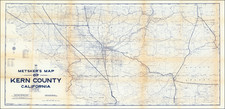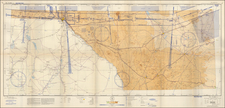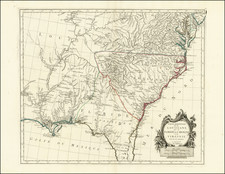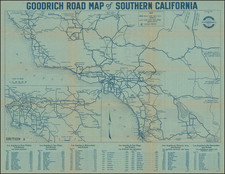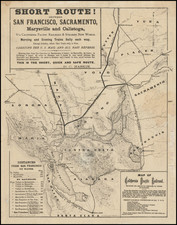The Earliest Printed Map to Depict the Escalante-Dominguez Expedition of 1776, with Highly Accurate Information in Colorado, Texas, and California
Rare map of Mexico, Texas, Upper California and contiguous regions, published in Spain at the beginning of the nineteenth century, which appeared in Juan Corradi's Descubrimiento y Conquista de la America o Compendio de la Historia General del Nuevo Mundo.
Virtually unknown until recent years, the map is extraordinarily well-researched for its date and context of illustrating an abridged and translated adaptation of William Robertson’ History of America (1777). For the first time in a printed map, it incorporates manuscript information available only in the Spanish archives about the American Southwest.
The map shows the entirety of what was then Nueva España, or New Spain, which included much of the current continental United States. North America is drawn from 40°N southward, from the Pacific Coast of California east to the Louisiana Territory, with just a sliver of Florida included. The western Gulf of Mexico is shown, as is all of present-day Mexico.
The land is densely spotted with mountains. The river systems are very detailed, one of the strengths of the map. Between California and the territory of Nuevo Mexico is Apachería, a nod to the Apache people who lived there. Below the title is an inset of Mexico City and the lake system that surrounded it. Today, most of these lakes have been drained.
In the northwest corner of the map is the toponym Quivira. Starting in the sixteenth century, the legendary Seven Cities were believed to be located in as yet unexplored areas of New Spain—the seven cities of Cíbola and Gran Quívira. In 1540, this belief, likely combined with various indigenous legends, led Francisco Vázquez de Coronado to embark on an (unsuccessful) expedition to find these mythical cities. Coronado gave the name Quívira to parts of Kansas, Nebraska, and Utah.
Despite the inclusion of the mythical Quivira, this map was exceptionally up-to-date with the latest cartographic and hydrographic information from Spain’s Dirección Hidrográfica, as the title explains.
The Escalante-Domínguez Expedition and sources for this map
The map includes the most recent possible information about the western slope of Colorado, Texas, and what is today Arizona and New Mexico. Much of this information is clearly drawn from Bernardo de Miera y Pacheco’s 1777 manuscript map, “Plano de la Provincia Interna del Nuevo Mexico,” which was based on the observations of the Escalante-Domínguez expedition of 1776.
The expedition was the first known European excursion in the Uinta Basin; it was led by two priests, Atanasio Domínguez with Silvestre Vélez de Escalante. The latter kept a journal of their travels. The purpose of the expedition was to find an overland route from the mission at Monterey, California, to Santa Fe, New Mexico. Their small group made their way from Santa Fe through Colorado, but they had to turn back in the Utah Valley. Although they did not reach their goal, they did map an area entirely new to Europeans.
In particular, the treatment of the Rio Dolores, with its prominent bend, and the Rio San Juan (Rio Navajo), with its tributaries, are clearly derived from Miera y Pacheco’s map (which can be seen here). This map also includes an error shared with Miera y Pacheco, the Rio Buenaventura (Green River) runs into Sevier Lake instead of the Colorado River.
Interestingly, no other printed map would show the findings of the Escalante Domínguez Expedition until Humboldt’s landmark “Carte Generale du Royaume de la Nouvelle Espagne…”, first printed in 1811. Indeed, Humboldt’s approximation of Miera y Pacheco’s cartographic content is inferior to what is seen here.
Other sources for this map include the “Carta Esférica que Comprehende Las Costas Del Seno Mexicano…,” published in Madrid in 1799 by the Depósito Hidrográfico, an institution related to the Dirección. That chart, seen here, is generally regarded as the most important Spanish charting of the Gulf of Mexico in the eighteenth century.
Corradi also incorporates information from Miguel Costanzo's “Carta Reducida del Oceano Asiatico” of 1771 for its depiction of the California coast. Corradi's map shows the San Francisco Bay area and the Sacramento River (Rio de Los Dolores) in a remarkably accurate manner for the time, although the Sacramento River is shown to penetrate the Sierra Nevada. Also shown is the Rio Carmelo and R.S. Felipe, incorrectly flowing through much of central California.
In southern California, the Mohave River (R. de Los Martiers) is not portrayed well and is shown as flowing into the Colorado River. Depagter notes that Corradi may have incorrectly labeled the Virgin River as the Mohave, as the Virgin River does drain in to the Colorado and at that time was known as R. de Las Pyramides. The Gila River is fairly accurate, with Tucson (Tubson) located too far east and with a fictitious lake to the north.
Further east, the Rio Grande is depicted (Rio Grande del Norte and Rio Brabo), while the Rio Pecos is shown but not named. In the Big Bend area, the name Parral appears. It is possible that this is a mis-location of the town of Parral, which was founded after a silver strike in 1631, and/or the location of one of the five defensive points set up by the Spanish to defend against the Apaches dating to the 1690s.
Going up the coast from the mouth of the Rio Grande is the R. de Las Nueces (The Nueces River). Next are two unnamed rivers coming out of a bay. These are probably the San Antonio and Guadalupe Rivers. San Antonio appears to be marked but not named. The Rio Colorado, de Nachitos o de Las Canas is prominently shown. An unnamed Trinity River is shown to be flowing into B. de Galveston (Trinity and Galveston Bays). The next river is named R. Alibanos (Neches River). On this river is a town named Cenis, the place name often cited as the earliest naming in Texas. On De L'isle's map of 1718 it appears as a prominent town with a note stating "Mission de Los Teijas Esjablie en 1716". The last river before the Mississippi is called the Rio Apalachicola and is most likely the Sabine River. A place name, Adaza, is shown, which may be Nacogdoches (Natchitoches).
The Mississippi Delta is depicted with good detail. Going up the Mississippi is the Rio Roxo, the Red River, with the Rio Negro, Black River, flowing into it. Further up the Rio Arkansas is very understated. Next is the Rio Blanco, White River. The Missouri River is named twice as R. Misuris and Misurio. The Kansas River is named Rio Puducas and a Peducas Village is shown nearby.
The publication of the Corradi maps
This map was one of three that appeared in Juan Corradi’s translation of Joachin Heinrich Campe’s adaptation of William Robertson’s History of America (1777). The latter was a hugely popular work that was translated, reprinted, pirated, and adapted dozens of times across Europe in the late-eighteenth and nineteenth centuries.
Corradi translated Campe’s German work into a three-volume Spanish set called Descubrimiento y Conquista de la America o Compendio de la Historia General del Nuevo Mundo. Rather than reuse existing maps, or adapt Kitchin’s maps made for Robertson into Spanish, Corradi instead acquired amazingly detailed maps for each volume.
- Vol. 1 focuses on the voyages of Columbus and has “Carta Esferica Del Golfo de Mexico e Islas Antillas”
- Vol. 2 discusses the expeditions of Hernán Cortes and has this map.
- Vol. 3 focuses on Pizarro, with a map of South America
While Corradi’s connection to Spain’s hydrographic body, the Dirección, is not clear, it is known who worked on these maps. Under Carlos III (r. 1759-1788), the centuries-old policy of tightly controlling Spain’s geographic knowledge lifted somewhat. It was under Carlos III’s orders that the Dirección was organized, with the initial guidance of Vincent Tofino.
While Carlos III’s son, Carlos IV (r. 1788-1808), returned Spain to a tighter regulation of cartographic content, this map seems to have slipped under the radar of censors. It was produced by Dirección hydrographers Tomás Gonzalez, José María Cardano, Felipe Cardano, and Juan Morata. The Cardanos were the engravers, Morata a draughtsman, and Gonzalez a geographic compiler. This cartographic dream team lent prestige to an otherwise unremarkable publication.
Placing the Corradi map in carto-bibliography
The following is a survey of the other major maps of Mexico and the Southwest from the eighteenth century:
- 1729, manuscript map by Barreiro, "Plano Cartográphico e Hydrográphico de las provincias del Nuevo Mexico" ( see Paul E. Cohen, Mapping the West)
- Ca. 1768, printed map by Joe Antonia de Alzate y Ramierez, “Nuevo Mapa Geográphico de la Amárica septentrional…”
- 1771, the aforementioned manuscript map by Miguel Costanzo
- 1778, the aforementioned manuscript map by Miera y Pacheco
- 1799, the aforementioned Gulf of Mexico chart
Corradi's map is almost certainly the second printed map of the Southwest after the Alzate map of circa 1768, and the only map to incorporate Miera y Pacheco's information from the Escalante-Domínguez Expedition. Moreover, it is superior to Humboldt's map, predating it by nearly a decade and utilizing more accurate and advanced information of the lower western Rockies.
Rarity
The map is quite scarce on the market. This is the third example we have offered in over twenty years.









![[ Yucatan ] Karte der Halbinsel Yucatan, hauptsächlich nach der von Joachim Hubbe und Andres Aznar Perez zusammengestellten und von C. Hermann Berendt revidirten und vermehtren Mapa de la Peninsula de Yucatan von 1878](https://storage.googleapis.com/raremaps/img/small/96420.jpg)
